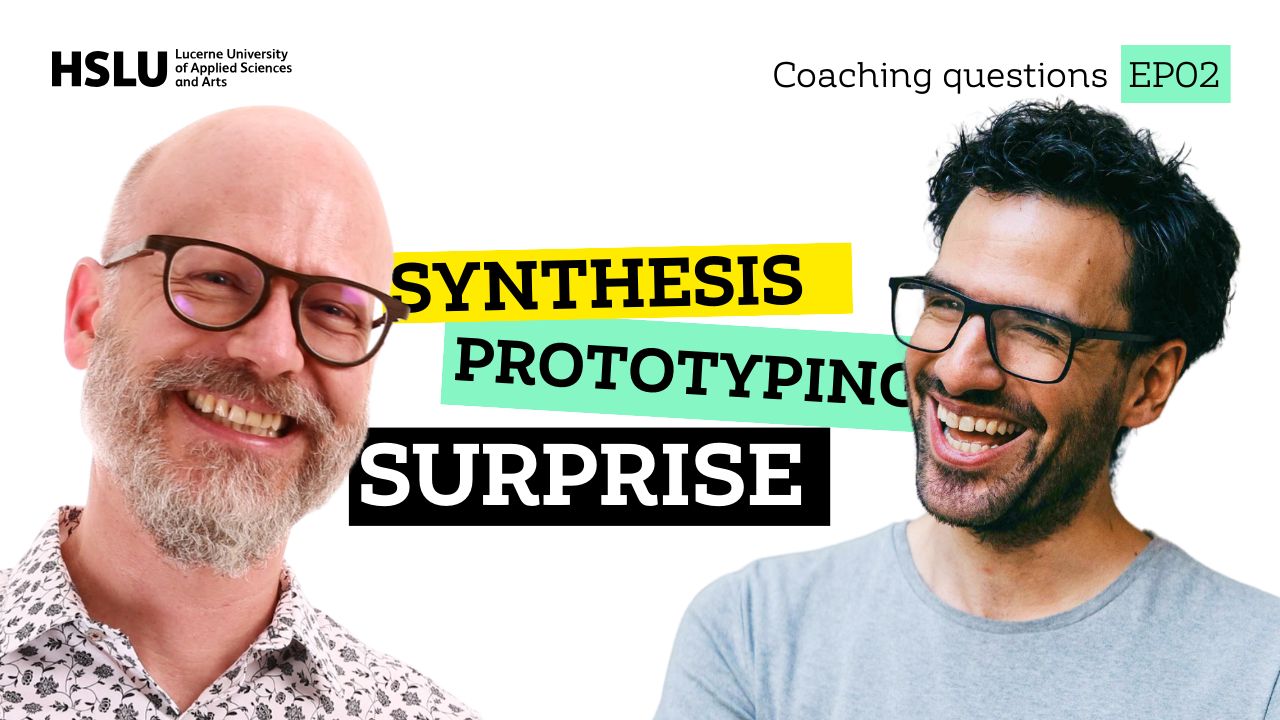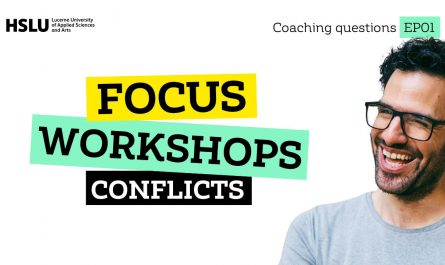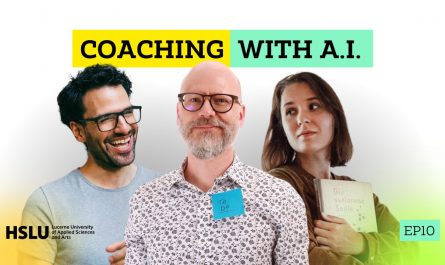With Andy Polaine we’ve exchanged our summary notes in a video about two questions:
- How to prototype when you’re not a maker or designer?
Thanks Sofiia Kaminska for the question - What should I do with all the research?
Thanks Kseniia Marchenko for the question
Watch the video
Transcript
This transcript was generated using Descript, which means the text can be pretty creative or just plain wrong at times. So, take it with a grain of salt.
Track 1: Today we had another coaching session at the HSLU about Service Design. And I’m here with my mate, Andy Polaine, to just share a few of these good questions that came from students. So Andy, what’s one of the questions that resonated with you today?
What do I do after research?
Andy: So Sophia came with a question today, which I hear a lot:
I’ve done all my primary research, I’ve done a lot of secondary research, I’ve gone and spoken to people, done workshops, I’ve read all the literature, all that and what do I do with it?
And it’s often I see a leap to, I’ve now got an idea, and, and she was saying, do I need a framework? Do I need to find something? And. I think the answer to this often is you need to do the analysis and synthesis of the research. So you need to have those themes both in the primary research, the literature and case studies and everything else you’ve looked at. What are the kind of themes and you might find there’s a framework here, a set of principles there or some criteria here and some of that is then synthesizing that and going out of that and going to extract these four or five things that are going to drive the ideation that I’m going to be doing as you would do with the primary research or your interviews and the rest of it. We’ve got a kind of bunch of unmet needs or opportunities in those things. And then we bring those two together. You’re really saying I could do this or I could do that. What do my criteria tell me would be the right decision to be going for here? And it’s very tempting to go to, I’ve got an idea and now I’m going to work on it and iterate it. The bit that they often miss and the bit I always used to say to you that you made a big thing out of is come up with your a hundred shitty ideas, go then broad and really generic lots of stuff. You’ll get through all the easy ones first. You’ll start to get a bit stuck and then you’ll get ridiculous ones that you might find a real sort of little kernel of interesting opportunity in. You will stumble across an idea that is what I call generous, right? Where you’ll go, there’s a theme there or there’s a kind of area there. And when I think about it, there’s one, I could do that and I could do that and I could do that and I can do that. And those are the ones to go for, right? Rather than, I’ve got my idea, but it’s a mean idea, it’s not generous, and I’m really struggling to pull anything out of it, and I’m just there, and I sat there, and I’m looking at it, and it’s just not coming. Just get rid, just, jettison that one, go on, maybe it comes back later. But you don’t get to have that kind of exploration unless you have a really broad idea. Ideation. And when you’re a master student, you’ve got a piece of work, you’ve got time to do a piece of work where there is no stakeholders to please, there’s no kind of boss telling you what to do. You can do whatever kind of crazy thing you want. And now’s the time to do that. That’s my answer to that question. What about you?
Daniele: Yeah, obviously I resonate a lot with the, with this notion, of of making a lot, because usually as I’m someone who is not a perfectionist, it really helps me to kill my imposter syndrome, to have a lot of stuff out. And I think for students also, who often have this kind of fear of, I’m not doing well, just doing a lot.
It’s like the luxury thing. If you do enough, there will be something good that comes out of it. I think that’s one big piece here. Maybe a provocation that I could add to this is like the ping pong thinking, where often people think about research as like this linear thing where you do the research, then you do the synthesis, etc.
it step by step. And what if you did it in a ping pong fashion where, you’re doing the research, but after an interview, you can already prototype something, you can already sketch something. Because Obviously, it’s fun to do, and thinking, okay, I did this interview.
What could it mean right now? And I know I’m going to park this idea, but just for already thinking a little bit in a hands on way. And strangely enough, that’s synthesis, but it’s synthesis with hands instead of And that’s like an a provocation that I often like to do also with students, just have fun, do some stuff.
Just do some stuff, don’t get stuck in the
Andy: Yeah. Be a designer, right? Your job is to invent stuff and make stuff up. Yeah, good. Good provocation.
Daniele: And maybe if we add another one, because we’re very provocative both us, would be to remember from where you come, often I hear, illustrators say, ah, it’s hard for me to research thing because I’m an illustrator. I’m someone who likes to draw, who said you can’t draw? Like use these skills also to do your synthesis, to do your to summarize stuff. I think that’s another thing that can really help and make it
Andy: You just made me think of something else, which is also to think of where you’re going, right? Because when you’re doing a master’s project, it’s going to be a big piece of work that will form part of your portfolio. And you will get more of that kind of work because that’s how, that’s how people work.
Show us what you’ve done. Oh yeah, we’re looking for someone who can do that. Can you do it for us again? And there’s a real opportunity to think about, what methods or, making methods or what things am I rubbish at and I’d like to try out and get good at. But also, what do I want to have as a thing at the end that is going to show the kind of work I want to be doing.
So that’s very useful to, to guide your ideation.
Track 1: Absolutely. And obviously we could go much deeper in all of these questions.
How to prototype when you’re not a designer?
Daniele: I’m going to share another which is from Kseniia and she is asking:
I’m not a maker, how do I prototype?
So she’s not coming, from the classical design degree thing, graphic design or product design, but still she is learning all things about service design.
And so she’s struggling to. Get started with prototyping. Obviously, I have a few ideas, but I’m interested in yours. What would you have
Andy: I get to go first. So you’ve got it so good these days, kids, there are so many tools and platforms out there, whether it’s something like Canva or there’s a whole bunch of templates and design patterns and stuff. And to prototype something it depends on what you’re trying to prototype and what you want to get out of it.
But you can make some nice looking, and they don’t have to be amazing, but you can make some decent looking. Tangible artifacts using all of that stuff in general what you’re looking with that service design first prototype at the very least is, what’s the value proposition, what’s the service proposition, people understand it, and also is it coherent, and so you can, the coherent bit you can borrow, you can stand on someone else’s shoulders and go, you know what, the whole kind of design, Here there’s a whole bunch of templates for, how I present, for kind of what a mock up of a website might look like, what a mock up of an ad might look like, what some, I don’t know, some physical things might look like that you can use. In Senya’s case, I know there’s also some 3D actual kind of product stuff. There are bunch of tools from so from Google or for using, that people use for kind of 3D printers they’re not, there’s also a whole library of kind of 3D objects and stuff. So there’s some things that you could play with.
It’s certainly worth a little experiment with and say, can I do the kind of Lego version of this and get something similar? But you know also at the very least, if you can do a stickman storyboard, that might be good enough because actually what you’re trying to do is just to get the sense of the day in the life of or the kind of hero journey through this and understand, what are the key steps, what are the transitions and so forth. And then later you can think about, Oh, I need to make something that looks nice. But really you’re just trying to get a sense of the kind of ecosystem and the flow of that first. That’s my view.
Daniele: Yeah, and Canva is such a beast. People don’t know how good this thing is, like just being able to get a template and then, removing backgrounds, even generate images stuff. It’s it’s pretty strong and it’s free. It’s free. So this is crazy.
On my side, the way I answered it, I said, you know, do you, when you were a kid, did you play Lego? Yeah.
Andy: Yeah.
Daniele: And she said, yeah. Okay, so you know how to prototype because that’s one way you can prototype, just build something with Legos and that usually works pretty well with services, which are interactions that are intangible.
not just usually just not just a wire frame. It’s like a more complex thing. And you can, tell a story saying, okay, this is this person, this is Bob. And you can tell the story of Bob going through the different steps. And. We have smartphones, so we can just record ourselves telling the story.
And that’s something that you can, do very simply. It’s visual, it’s a bit quickie, but it And if you don’t like Legos, you can do what A great mate that we both have, Manu Franiere from the HSSO Valais, he’s really deep into the kind of using theatre, to prototype stuff.
And obviously, that sounds like even more fancy and complicated, theater is just being with another friend of yours and say, you play the cop, I play the prisoner, and this is the setting let’s try something. And again, you can record it, and then you can share it, edit it, and you already have kind of a service experience there.
Ah. Especially, for all these non digital things, which I think are a big part of what we love about service design also using non digital ways of prototyping, Lego role play it, it just
Andy: Yeah. I think, one of the things with that is always to remember, what is it you’re trying to test? What is it you’re trying to find out? Discover? Because prototyping is not just about making a nice looking thing, but it’s about that. And. I think the other thing with all those intangible things is you don’t need much you can have really rubbish drawn things on a piece of paper and you know use a table as a you know whatever as a kind of prop and chairs and when you act it out you’re looking to see two things one you can go one you know how does this feel you What do I feel like?
What did that feel like being the service provider then? Did that feel weird? That interaction and that kind of stuff which is really useful with the acting out theatre bit. And I think the second bit is this idea that, as soon as you make something tangible, it’s what you were saying before to Sophia’s question you start thinking and you’ve got this idea in your head, it always seems perfect in your head and as soon as you make it, it’s oh, it’s really imperfect and there’s all these problems with it.
That’s really great, right? And as you start making your, you’re making to think. And you’re going, oh no, but that’s not going to work. Oh no, I see that. That’s never going to work. But I can do this. I could do that. And that’s a really important part of that. And for that, it doesn’t have to be sophisticated at all.
Summary
Daniele: And I think that’s the best tip that we can give based on all the previous coaching sessions that we did, but also just with these two elements, which is. I think, don’t take it so let’s have some fun and, like not overcomplicate it because the goal of all of these things is just to get started somewhere.
And usually once you get started, that’s when then the work happens, because the hard thing is to The difficult thing is to start, it’s not to then improve it. So find something simple that you can use to just get started.
Andy: Very good. Very good. I agree. Absolutely agree.
Surprise
Daniele: But before we leave, I think we have a bit of. Good news for people interested in service design. What’s the good
Andy: The good news is the applications for the Masters of Service Design have been extended to the 15th of June 2024. And we’ll put a link below to tell you where to go for that. So anyone interested in studying with Daniele and myself and all our lovely colleagues go for it.
Apply, and we’ll be looking forward to seeing you in Lucerne.
How would you answer those questions?
andy-polaine_1_03-20-2024_174341: And for any of our peers who might have different answers to ours, they might disagree, you can put those in the comments too.



